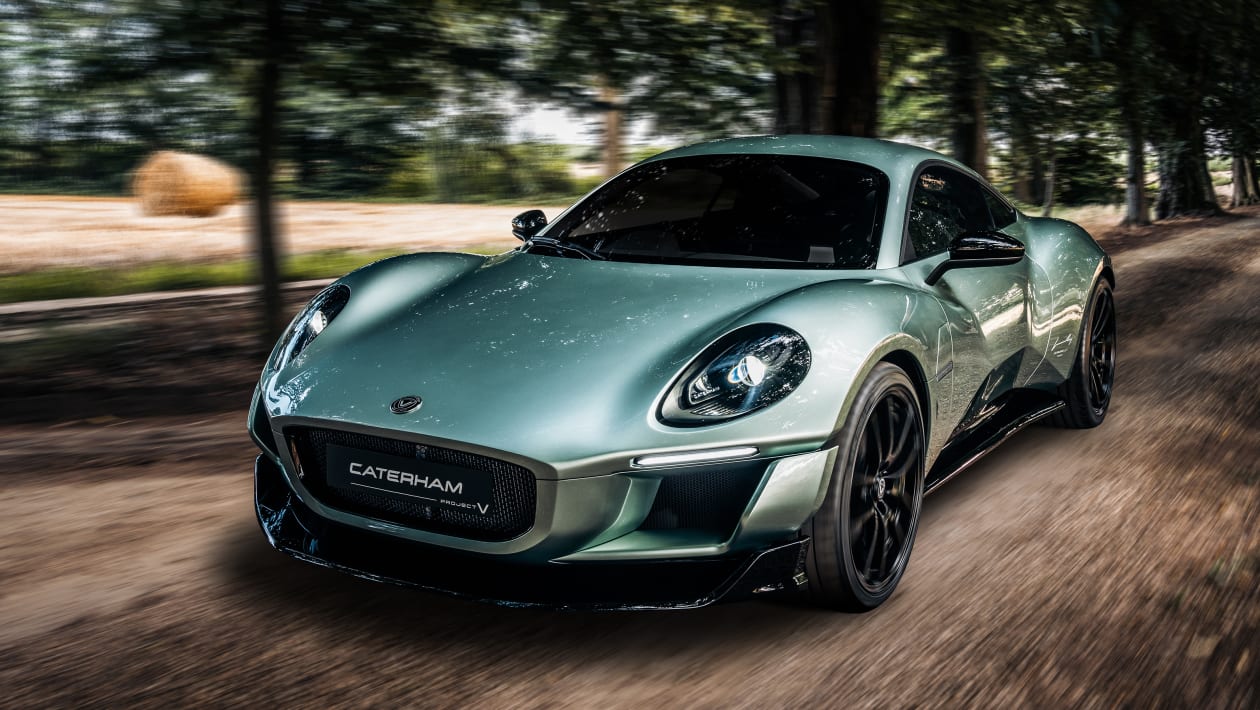New Caterham Project V unveiled: lightweight EV sports car to reach …

The future looks uncertain for small-volume sports car[1] makers, with UK legislation forcing combustion engines off the market in 2030. For Caterham[2], a company built on lightweight principles and simplicity, the move to electric power doesn’t seem to fit, but this hasn’t stopped it preparing for the all-electric era with the car you see here: the Project V.
Previewing a production car that will arrive by 2026 with a starting price of less than £80,000, the Project V transfers Caterham’s core engineering principles into a battery-powered package. Underpinned by a bespoke aluminium and carbonfibre chassis with double-wishbone suspension at each corner, the Project V weighs in at 1190kg – just a passenger more than an ICE-powered Alpine A110[3] – and it’s been designed to open up Caterham to a wider market than the specialised, more extreme Seven. As such, it offers certain concessions to usability such as a closed-roof coupe design, electrically assisted steering and modern interior tech.
The Project V’s performance isn’t of the neck-snapping kind we’re used to from electric performance cars, but it’s quick by any other measure. With a single 268bhp electric motor powering the rear wheels, the Project V completes the 0-62mph sprint in 4.5sec and runs on to a top speed of 143mph. Since the motor has a relatively modest output, it doesn’t need an enormous, heavy battery to achieve a respectable range; with a 55kWh capacity, the Project V achieves 249 miles from a single charge. A 20-80 per cent top-up takes just 15 minutes when using a 150kW rapid charger.
With its stripped-back ambience, button-free steering wheel and bare carbon dashboard, the Project V’s lightweight ethos carries through to the interior, which uses a digital instrument pack and a smartphone-mirroring touchscreen for multimedia functions. Thankfully, there’s a call-back to tradition with a bank of physical dials and toggles below the central display – one of which switches between the Project V’s Normal, Sport and Sprint drive modes.
Need to sell your car?
Find your best offer from over 5,000+ dealers. It’s that easy.
The concept’s 2+1 cabin layout makes it the most practical Caterham yet, with padded sections on the rear bulkhead forming a centrally mounted rear seat. A conventional four-seat configuration has also been developed, though this comes with a slight weight penalty. To seat the driver as low as possible – not always achievable in an EV with under-floor batteries – the battery unit is split in three, with two packs under the rear seat and another beneath the front footwells.
Styled by Caterham’s newly appointed design chief Anthony Jannarelly, the Project V integrates modern touches into a classically proportioned bodyshell. With flowing, muscular haunches and a tapered rear end, the Project V's silhouette recalls sports prototypes from the '60s and '70s. This should come as no surprise, given that the retro-styled Jannarelly Design-1[4] drew from similar inspiration. With 19-inch front and 20-inch rear wheels shod in Michelin Pilot Sport 4 S rubber, the Project V has the largest wheel and tyre package ever fitted to a Caterham.
Jannarelly was one of six design houses and individuals approached by Caterham to submit a clean-sheet design for the new model, and his proposal won out. Italdesign was enlisted to build the show car, and evo was invited to provide input on its paint colour and interior trim during a visit to the Turin firm in March. The end result is a curvaceous coupe that’s ‘a little lower, a little wider, and about the same length’ as a Porsche Cayman, according to Jannarelly himself.
Debuting at the Goodwood Festival of Speed, the Project V concept lays down the basics for a production variant that is expected to launch in two to three years’ time. According to Caterham CEO Bob Laishley we can expect much of the design to remain intact once the car reaches showrooms.
‘We’re a small company,’ he told evo. ‘We can't afford the luxury of making a styling model and then grind it up and throw it away after it’s got some headlines. We wanted this to be as close as the car that we want to make in production, so there's been a lot more consideration of engineering.’
References
- ^ sports car (www.evo.co.uk)
- ^ Caterham (www.evo.co.uk)
- ^ Alpine A110 (www.evo.co.uk)
- ^ Design-1 (www.evo.co.uk)